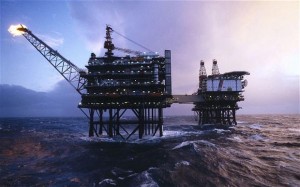 Both West Texas Intermediate and Brent crude benchmarks extended losses on Friday as lingering demand in the US and global supply outstripping demand fueled bearish sentiment. A strong US dollar pressured the market additionally, but overall positive manufacturing data from Europe and China kept a floor under prices. Natural gas pared weekly gains as short-term weather forecasts called for mild weather across most of the US to persists through the next few days.
Both West Texas Intermediate and Brent crude benchmarks extended losses on Friday as lingering demand in the US and global supply outstripping demand fueled bearish sentiment. A strong US dollar pressured the market additionally, but overall positive manufacturing data from Europe and China kept a floor under prices. Natural gas pared weekly gains as short-term weather forecasts called for mild weather across most of the US to persists through the next few days.
On the New York Mercantile Exchange, WTI crude for delivery in September stood at $97.70 per barrel at 12:38 GMT, down 0.48% on the day. Prices held in a daily range between $98.10 and $97.09, the lowest since February 5th. The US crude benchmark plummeted 2.09% on Thursday to close the session at $98.17, the lowest settlement since March 17th. The contract slid 6.8% in July, posting its worst monthly performance since May 2012.
Meanwhile on the ICE, Brent for settlement in the same month was down 0.38% to trade at $105.62 a barrel. Prices ranged between $106.12 and $105.31 a barrel, the lowest since April 2nd. The European crude benchmark shed 0.46% on Thursday to settle the month at $106.02, dropping 5.6% for the month – the biggest decline since April 2013. Brent traded at a premium of $7.92 to its US counterpart, up from Thursday’s settlement at $7.85.
Oil prices remained pressured to the downside after government data showed on Wednesday that US motor gasoline stockpiles rose to a four-month high, despite being in the middle of the peak US driving season. Additionally, a Reuters survey had shown earlier in the week that OPEC pumped more oil in July compared to June, in spite of the turmoil in Iraq and Libya. Iraq’s output remained near record-high levels.
Motor gasoline inventories rose by 0.365 million barrels to 218.2 million, the highest since March. This was below analysts’ projections for a 1-million jump, but also trailed API’s data which had shown on Tuesday a 60 000-barrel increase. Consumption of the fuel slid by 0.5% over the last four weeks to 8.95 million barrels per day, the lowest since May.
Distillate fuel stockpiles, which include diesel and heating oil, added 0.789 million barrels to stand at 126.7 million, the most since September. Analysts had expected a 1.5-million-barrel increase.
US crude oil inventories fell for a fifth week by 3.7 million barrels to 367.4 million in the seven days through July 25th, while Supplies at Cushing, Oklahoma dropped to 17.9 million barrels, the lowest since October 2008, down from 18.8 million a week earlier.
US crude demand may be additionally pressured by a prolonged shutdown of a Coffeyville, Kansas-based refinery which caught fire on July 29th. The 115 000-barrel-per-day refinery, which feeds crude from Cushing, Oklahoma, may see an extended maintenance of up to four weeks.
Manufacturing activity
Providing some support, China’s vast manufacturing sector expanded at the fastest pace in more than two years in July. Government data provided by the National Bureau of Statistics showed China’s Manufacturing PMI edging up to 51.7, beating estimates for a jump to 51.4 from June’s 51.0.
The reading matched estimates by HSBC and Markit Economics, whose private gauge, at 51.7, was the highest in 18 months, in spite of trailing expectations for a jump to 52.0 from June’s final reading of 50.7.
The private report highlighted that output and total new orders both rose at the strongest rates since March 2013, while new export work increased at the second-fastest pace in over 3-1/2 years. As a result, purchasing activity rose solidly while job shedding eased for the second successive month and was only slight.
Additionally, Markit Economics reported that manufacturing activity in France further contracted July, with the Markit Manufacturing PMI scoring at 47.8, down from 48.2 in June but beating projections for a further drop to 47.6.
Germany’s manufacturing sector posted a smaller growth from what preliminary estimates showed, with the German Manufacturing PMI registering at 52.4 in July, trailing the flash reading’s 52.9. However, this was an improvement compared to June’s final reading of 52.0.
The Eurozone as a whole saw manufacturing activity growth unchanged at 51.8 in July, slightly below preliminary estimates of 51.9 released earlier in the month. This was the 13th straight month of expansion.
Britains manufacturing sector also marked an improvement, but it grew at the slowest pace since March 2013. The British manufacturing PMI scored at 55.4, compared to expectations to remain flat at 57.2.
In the US, data by the Labor Department showed that US nonfarm payrolls increased by 209 000 in July, underperforming projections for 233 000, while Junes reading received an upward revision to 298 000 from initially estimated at 288 000. The US unemployment rate inched up to 6.2%, up from 6.1% in June. Both personal income and spending matched projections and rose by 0.4% from a month earleir.
Natural gas
Natural gas fell on Friday after jumping by almost 1.5% on Thursday as weather forecasts called for overall mild weather across most of the US in the next several days. However, an upcoming decent warm-up is expected to support prices to the upside as early as next week, although another larger-than-projected weekly build in nationwide gas inventories is to be expected.
On the New York Mercantile Exchange, natural gas for delivery in September traded at $3.798 per million British thermal units at 12:42 GMT, down 1.12% on the day. Prices ranged between day’s high and low of $3.834 and $3.782. The energy source added 1.45% on Thursday after the EIA reported a smaller-than-expected jump in US gas inventories, to close the session at $3.841. Nevertheless, the power-plant fuel settled the month 14% lower, the biggest decline since March 2012, as widespread mild weather warranted above-average inventory injections.
Natural gas surged on Thursday after the Energy Information Administration reported an 88-billion-cubic-feet jump in nationwide gas inventories. Although the build almost doubled the five-year average gain of 46 billion cubic feet, it fell short of expectations for a jump in the range of 90-94 billion cubic feet.
Total gas held in US storage hubs rose to 2.307 trillion cubic feet, narrowing the deficit to the five-year average of 2.948 trillion to 21.7% from 23.5% a week earlier.
US weather
According to NatGasWeather.com’s weather forecast for the August 1 – August 7 period, temperatures over most of the US will begin to gradually edge higher late this week, paving the way for a slightly warmer trend. Currently, readings in the country’s central and southern parts are below normal after an unseasonably cool air mass pushed deep into Texas and the Southeast, ensuring comfortable readings and lower-than-usual cooling demand. As we have reported in the previous days, the western and southernmost areas of the country remain warm to hot, inducing moderate-to-high local electricity demand to power air conditioning.
In the time span between August 8th and August 14th, NatGasWeather.com expects high pressure to set up over the eastern, southern and western parts of the country, with temperatures rising to between 90 and 100 degrees Fahrenheit. The Midwest and Northeast will see readings climbing into the the 80s and lower 90s. However, the country’s northern areas will remain vulnerable to cooler Canadian weather systems that will probably attempt to push into the US around the middle of August. The remaining portion of the country will see warm weather driving seasonally high cooling demand, starting at moderate levels early next week.
Although nationwide cooling demand is currently lower than normal, it is expected to jump to moderate early next week as weather across most of the US becomes warmer, especially in the high-demand states of Texas, Oklahoma and the Southeast.





